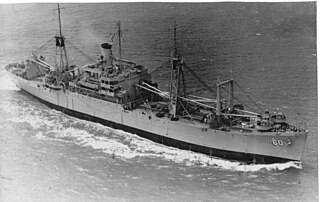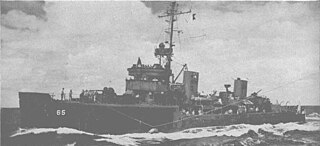
USS Mustin (DD-413) was a Sims-class destroyer of the United States Navy, the first Navy ship of that name, in honor of Captain Henry C. Mustin (1874–1923), a pioneer of naval aviation.

The third USS Farragut (DD-348) was named for Admiral David Glasgow Farragut (1801–1870). She was the lead ship of her class of destroyers in the United States Navy.

USS Chauncey (DD-667) was a Fletcher-class destroyer of the United States Navy, the third Navy ship named for Commodore Isaac Chauncey (1779–1840).

USS Leo (AKA-60), an Andromeda-class attack cargo ship, was named for the constellation Leo. She is the only ship of the United States Navy to hold this name. USS Leo served as a commissioned ship for 10 years and 5 months.

USS Storm King (AP-171) was a Storm King class auxiliary transport of the United States Navy. She was designed as a troop carrier, and named after Storm King Mountain.

USS Whiteside (AKA-90) was an Andromeda-class attack cargo ship named after Whiteside County, Illinois. She served as a commissioned ship for 13 years and 4 months.

USS Alshain (AKA-55) was an Andromeda-class attack cargo ship in the service of the United States Navy. She was named after the star Alshain in the constellation Aquila, and served as a commissioned ship for 11 years and 9 months.

USS Virgo (AKA-20) was an Andromeda class attack cargo ship of the United States Navy, named after the constellation Virgo. She was later converted to an ammunition ship and redesignated as (AE-30). She served as a commissioned ship for 22 years and 4 months.

USS Aquarius (AKA-16) was an Andromeda-class attack cargo ship in the service of the United States Navy. She was named after the constellation Aquarius. She was one of a handful of World War II AKAs manned by officers and crew from the United States Coast Guard. She served as a commissioned ship for 2 years and 9 months.

USS Andromeda (AKA-15) was an Andromeda-class attack cargo ship in service with the United States Navy from 1943 to 1956. She was scrapped in 1971.

USS Haskell (APA-117) was the lead ship of her class of attack transports, built for the United States Navy during World War II. She was of the VC2-S-AP5 Victory ship design type. Haskell was named for the Haskell Counties of Kansas, Oklahoma, and Texas.

USS Electra (AKA-4) was an Arcturus-class attack cargo ship named after Electra, a star in the Pleiades star cluster in the constellation Taurus. She served as a commissioned ship for seven years.

USS LST-31 was a United States Navy LST-1-class tank landing ship used exclusively in the Asiatic-Pacific Theater during World War II. Like many of her class, she was not originally named and is properly referred to by her hull designation. Later she was named for Addison County, Vermont. She was the only US Naval vessel to bear the name.

USS Swallow (AM-65) was an Auk-class minesweeper built for the United States Navy during World War II. The ship was the second U.S. Navy ship named after the swallow. Swallow earned two battle stars for World War II service. She was sunk by a kamikaze aircraft off Okinawa on 22 April 1945. She was struck from the Naval Vessel Register on 2 June 1945.

USS Feland (APA-11) was a Doyen-class attack transport in service with the United States Navy from 1943 to 1946. She was scrapped in 1964.

USS Alpine (APA-92) was a Bayfield-class attack transport in service with the United States Navy from 1943 to 1946.She was sold into commercial service in 1947 and was scrapped in 1971.

USS Custer (AP-85/APA-40) was a Bayfield-class attack transport in service with the United States Navy from 1943 to 1946. She was sold into commercial service in 1948 and was scrapped in 1973.

USS Fayette (APA-43) was a Bayfield-class attack transport that served with the United States Navy from 1943 to 1946. In 1947, she was sold into commercial service, where she served as SS Robin Gray until being scrapped in 1972.

USS Sheridan (APA-51) was an Ormsby-class attack transport that served with the US Navy during World War II.

USS Belle Grove (LSD-2) was an Ashland-class dock landing ship of the United States Navy, named in honor of Belle Grove Plantation, the birthplace of President James Madison (1751–1836) in Port Conway, Virginia.




















